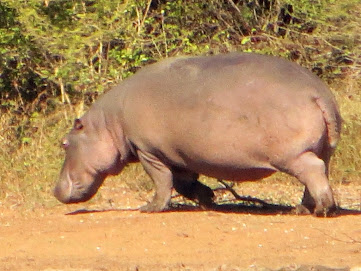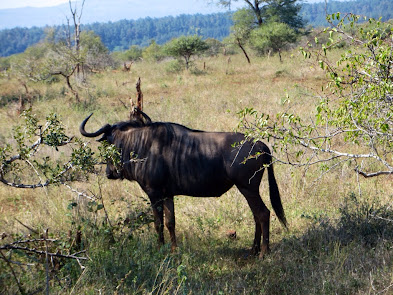The Lion (one of the big five) is Africa's largest and strongest carnivore. The lion is so powerful it can carry twice its own weight in its jaws. Lions are very social animals and live in prides of up to 30 or more. They are not frightened easily by people or cars in the park. A lion can eat as much as a quarter of its body mass in one sitting and can go for days without eating. We had two female lion spottings. Lions are much more difficult to spot in the wild as their coloring blends into the long grassy areas.
Some male lions weigh up to 550 pounds. Lions live for 10–14 years in the wild, while in captivity they can live longer than 20 years. In the wild, males seldom live longer than 10 years, as injuries sustained from continual fighting with rival males greatly reduce their longevity. They typically inhabit savanna and grassland, although they may take to bush and forest. Lions are unusually social compared to other cats. A pride of lions consists of related females and offspring and a small number of adult males. Groups of female lions typically hunt together. Sleeping mainly during the day, lions are primarily nocturnal.
Baboons are everywhere and they are not afraid of humans. Before leaving our camp each day we needed to ensure the kitchen doors were locked and we put a heavy metal table against the back door. They will look in windows, try doors and break through screens. If they get in to the kitchen they will tear it apart eating all the food and pooh everywhere. Driving along the road in late afternoons we often came upon large groups of baboons all over the road and if the vehicle windows are not up they will jump into the car looking for food - one jumped on the roof of our van.
Female baboons have the red bottoms which attract the males - to me they look disgusting and sore and in need of some ointment.
Rhinoceros (one of the big 5) are territorial. They demarcate their territories by regularly defaecating in the same location. There are white and black rhinos - we saw the black rhinos that have a more pointed mouth and use upper lip to browse. The rhinos we spotted were on the side of the road giving us an excellent photo opportunities.
An adult black rhinoceros stands 1.50–1.75 m (59–69 in) high at the shoulder and is 3.5–3.9 m (11–13 ft) in length. An adult weighs from 850 to 1,600 kg (1,900 to 3,500 lb), with the females being smaller than the males. Two horns on the skull are made of keratin with the larger front horn typically 50 cm long sometimes up to 140 cm. The black rhino is much smaller than the white rhino, and has a pointed mouth, which it uses to grasp leaves and twigs when feeding.
Redbilled Hornbill
Vervet Monkey - notice the blue testicles
Leopard tracks and leopard kill in a tree (an impala) - this is as close as we got to spotting a leopard - we did spot 4 of the big 5!
Crocodile
The hippopotamus (hippo is from the ancient greek for 'river horse') semi-aquatic, inhabiting rivers, lakes and mangrove swamps, where territorial bulls preside over a stretch of river and groups of 5 to 30 females and young. During the day, they remain cool by staying in the water or mud; reproduction and childbirth both occur in water. They emerge at dusk to graze on grass. While hippopotamuses rest near each other in the water, grazing is a solitary activity and hippos are not territorial on land. Hippos are recognizable by their barrel-shaped torso, enormous mouth and teeth, nearly hairless body, stubby legs and tremendous size. They are the third largest type of land mammal by weight (between 1½ and 3 tonnes): the only heavier species on average are the white and Indian rhinoceroses and the elephants, typically. The hippopotamus is one of the largest quadrupeds and, despite its stocky shape and short legs, it can easily outrun a human. Hippos have been clocked at 30 km/h (19 mph) over short distances. The hippopotamus is one of the most aggressive creatures in the world and is regarded as one of the most dangerous animals in Africa. Nevertheless, they are still threatened by habitat loss and poaching for their meat and ivory canine teeth.
One of the biggest highlights of our safari was when we spotted two cheetahs stalking an Impala. Then the Impala spotted the cheetahs and it was off at lightening speed while the cheetahs were in chase. Fortunately for the Impala the cheetah is not a good long distance runner - they only last running at top speed for about 90 seconds. Cheetahs look similar to a leopard but have shorter legs and are not as muscular. They also have a tear drop marking descending from their eyes. Because they are not a strong, muscular animal often their kill is taken from them by other animals and they will not fight as they cannot afford to have any injuries that would affect their ability to run short distances to hunt.
Warthogs live in holes in the ground. They are sensitive to low temperatures and need the hole for warmth and shelter. They enter the hole backwards so that any predator will have to reckon with their tusks before any harm can be done. They go down on their front knees to eat. They are an extremely ugly animal.
Wildebeest
Mongoose
African Fish Eagle with its catch!
African Eagle
I highly recommend putting an African safari on your bucket list - animal sightings, incredible scenery and topped off by having the best tour companions made this six days one of the highlights of my travels.



































No comments:
Post a Comment